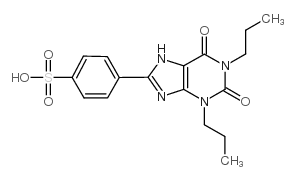Role of A1 receptors in renal sympathetic neurotransmission in the mouse kidney.
Edwin K Jackson, Dongmei Cheng, Zaichuan Mi, Jonathan D Verrier, Keri Janesko-Feldman, Patrick M Kochanek
Index: Am. J. Physiol. Renal Physiol. 303(7) , F1000-5, (2012)
Full Text: HTML
Abstract
A(1) receptors may participate in renal sympathetic neurotransmission by enhancing the postjunctional effects of norepinephrine. The purpose of this study was to test this concept using A(1) receptor knockout (A(1)AR-/-) mice. In isolated kidneys from nontransgenic mice perfused with Tyrode's solution at a constant rate, renal sympathetic nerve stimulation (RSNS) increased (P < 0.0001) renal venous perfusate levels of inosine (adenosine metabolite) from 23.9 ± 3.7 to 32.7 ± 5.1, 68.2 ± 12.4, and 94.0 ± 14.3 ng/ml at 3, 5, and 7 Hz, respectively (n = 28), suggesting frequency-dependent production of adenosine. Conversely, RSNS decreased (P < 0.0001) renal venous perfusate levels of 5'-AMP (adenosine precursor) from 1.4 ± 0.3 to 1.1 ± 0.3, 0.80 ± 0.2, and 0.6 ± 0.2 ng/ml at 3, 5, and 7 Hz, respectively (n = 28), suggesting frequency-dependent increased metabolism of 5'-AMP. In kidneys from nontransgenic mice, blockade of adenosine receptors with 1,3-dipropyl-8-p-sulfophenylxanthine attenuated (P = 0.0130) vasoconstrictor responses to RSNS at 3, 5, and 7 Hz [control (n = 29): 22 ± 4, 34 ± 6, 42 ± 6 mmHg, respectively; 1,3-dipropyl-8-p-sulfophenylxanthine-treated (n = 11): 6 ± 1, 12 ± 3, 15 ± 3 mmHg, respectively]. In A(1)AR-/- kidneys (n = 10), vasoconstrictor responses to RSNS at 3, 5, and 7 Hz were 7 ± 3, 20 ± 5, and 36 ± 9 mmHg, respectively. In kidneys from wild-type littermates (n = 9), responses were 27 ± 9, 58 ± 14, and 59 ± 11 mmHg, respectively (effect of genotype: P = 0.0363). In kidneys from nontransgenic mice, 2-chloro-N(6)-cyclopentyladenosine (CCPA; highly selective A(1) receptor agonist) increased renal vasoconstriction induced by norepinephrine (P = 0.0008; n = 28). In kidneys from A(1)AR-/- the response to norepinephrine was attenuated and the ability of CCPA to enhance responses to norepinephrine was abolished. In conclusion, adenosine formed during RSNS enhances the postjunctional effects of released norepinephrine by activating A(1) receptors.
Related Compounds
| Structure | Name/CAS No. | Molecular Formula | Articles |
|---|---|---|---|
 |
1,3-DIPROPYL-8-P-SULFOPHENYLXANTHINE
CAS:89073-57-4 |
C17H20N4O5S |
|
Extracellular 2',3'-cAMP-adenosine pathway in proximal tubul...
2013-01-01 [Am. J. Physiol. Renal Physiol. 304(1) , F49-55, (2013)] |
|
Expression of the 2',3'-cAMP-adenosine pathway in astrocytes...
2011-09-01 [J. Neurochem. 118 , 979-987, (2011)] |
|
Sustained reduction in myocardial reperfusion injury with an...
2000-03-01 [J. Pharmacol. Exp. Ther. 292(3) , 929-38, (2000)] |
|
Interaction of carbon monoxide and adenosine in the nucleus ...
2003-09-01 [Hypertension 42(3) , 380-5, (2003)] |
|
Angiotensin converting enzyme inhibition prevents trophic an...
2002-04-19 [Eur. J. Pharmacol. 441(1-2) , 99-104, (2002)] |